Echoes of Slave Patrols in ICE Raids: What Abolitionists Can Teach Us
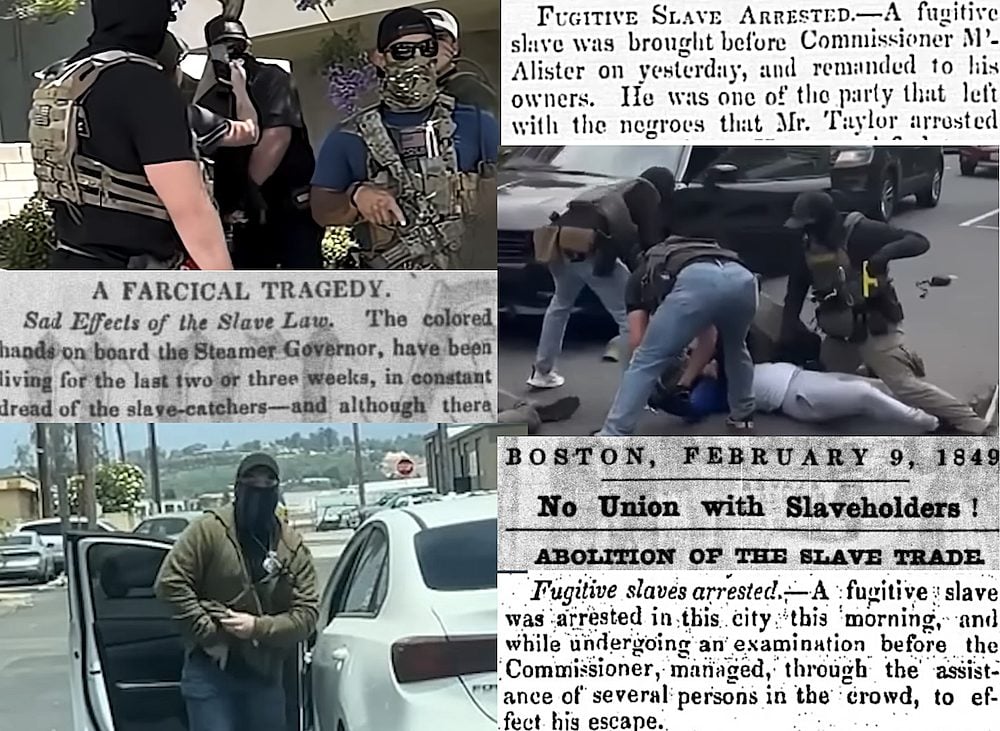
Historical parallels between America’s fugitive slave laws in the 1800s to today’s ICE raids, from top left to bottom right: Unidentified agents arrest street vendor, June 2025; fugitive slave arrested, February 1851; a farcical tragedy, sad effects of the slave law, October 1850; federal agents tackle and arrest food delivery driver, August 2025; masked ICE agent pulls gun on community activist, July 2025; no union with slaveholders, February 1849; fugitive slaves arrested, October 1851. (Images compiled by Shari Rose)
August 20, 2025 ~ By Brooke Pland
The slave patrols of the American South leveraged domestic terror and racist legal tactics to deny the rights of targeted communities in a deeply prejudicial and inhumane system; Trump’s ICE follows an all-too-familiar historical playbook in 2025
Since President Donald Trump retook office in January 2025, raids conducted by U.S. Immigration and Customs Enforcement (ICE) have increased exponentially across the country, with a growing number of encounters appearing blatantly unconstitutional. Historical parallels to the 19th-century system of slave patrols in the Antebellum South paint a scary reality for modern-day America, from ICE’s strategy of widespread fearmongering to its overtly racist agenda. In the same way abolitionists protected Black Americans from slave catchers, today’s communities can work together to protect their immigrant neighbors, too.
- History of Slave Patrols in the United States
- How ICE Follows Similar Principles of the Slave Patrol System
- The Role of Intimidation and Racism in ICE Raids
- American Abolitionist Methods for Resisting Slave Catchers
- How Today’s Anti-ICE Efforts Can Learn from the Historical Abolitionists
History of Slave Patrols in the United States
Beginning in the Carolinas as early as 1704, slave patrols were established to systematically prevent and crush rebellions, instill fear, and make permanent escape impossible for enslaved persons. Based on Article 4 of the Constitution, which requires states to deliver fugitives from labor when requested by overseers, the Fugitive Slave Acts provided a legal framework in which these patrols operated.
The first of these statutes, passed by Congress in 1793, permitted enslavers and their “agents” to search for individuals fleeing enslavement within the borders of any state, including the free Northern states of the Union. Slave catchers could then capture these freedom seekers and bring them before a judge with proof that these people were, in fact, their property.
The second measure passed, Fugitive Slave Act of 1850, was intended to mitigate the South’s growing discussion of secession in the face of the abolition movement, and was even harsher than the first. The statute allowed for the involvement of federal agents, revoked enslaved people’s ability to testify in court, and warranted jail time for civilians who assisted freedom seekers.
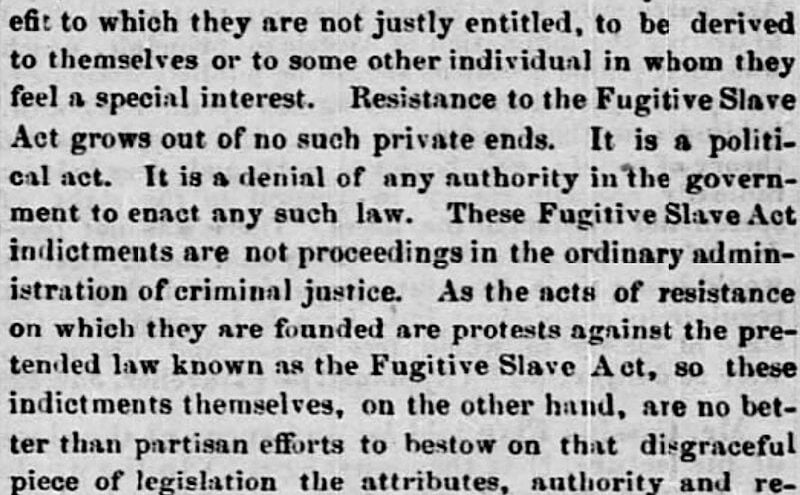
In an article published on February 9, 1855 in The Liberator, a writer opposes the argument that those who fight against the Fugitive Slave Act of 1850 are no better than common criminals. The article says in part that resistance to the law “…is a political act. It is a denial of any authority in the government to enact any such law. These Fugitive Slave Act indictments are not proceedings in the ordinary administration of criminal justice.” (Source)
The history of the slave patrol system had three main functions, according to Eastern Kentucky University College of Justice and Safety professor Dr. Gary Potter: To track down, capture, and return people fleeing enslavement; to “provide a form of organized terror” intended to discourage rebellion by enslaved people; and “to maintain a form of discipline for slave-workers who were subject to summary justice, outside of the law.” The patrols had legal authority to enforce Southern slavery laws, punish enslaved people as they saw fit, and search plantations for freedom seekers or any unwanted assembly of enslaved people.
To make matters worse, slave catchers frequently abducted free African American citizens from Northern states, claiming they were fugitives, and sold them into slavery in the South. “For decades [before the Civil War],” reports the Jack Miller Center, an educational nonprofit, “slave catchers, as well as slaveholders and professional kidnappers, [prowled] the streets of the city, assaulting Black Americans by any means to enslave them.”

In his defense of a personal liberty bill up for repeal by pro-slavery lawmakers, abolitionist Wendell Phillips described the lack of due process allowed by the Fugitive Slave Act in a speech on January 29, 1861: “It says that [a man’s] liberty may be sacrificed, on the affidavit of nobody knows whom, taken nobody knows where, before nobody knows what. No opportunity to cross-examine that witness, no opportunity, even, to know whether the apparent judge who signs the affidavit is a judge, whether the person who makes it is a living being, no means of cross-examination or scrutiny whatever.” (Source)
How ICE Follows Similar Principles of the Slave Patrol System
During his 2024 presidential campaign, then-former President Trump spoke widely about his plan to tighten the enforcement of American immigration law. Since his reelection, however, the president has taken this focus much further than he’d ever discussed from outside the White House, to the alarm of legal and undocumented residents alike.
Beginning with the president’s January 20th executive order titled, “Protecting the American People Against Invasion,” this action immediately overturned former President Biden’s executive orders 14010 and 14011. By overturning “Orderly Processing of Asylum Seekers at the Border” and “Establishment of Interagency Task Force on the Reunification of Families,” the second Trump administration swiftly established legal precedent for the widespread pursuit of not just convicted criminals, but of undocumented people with no criminal backgrounds.
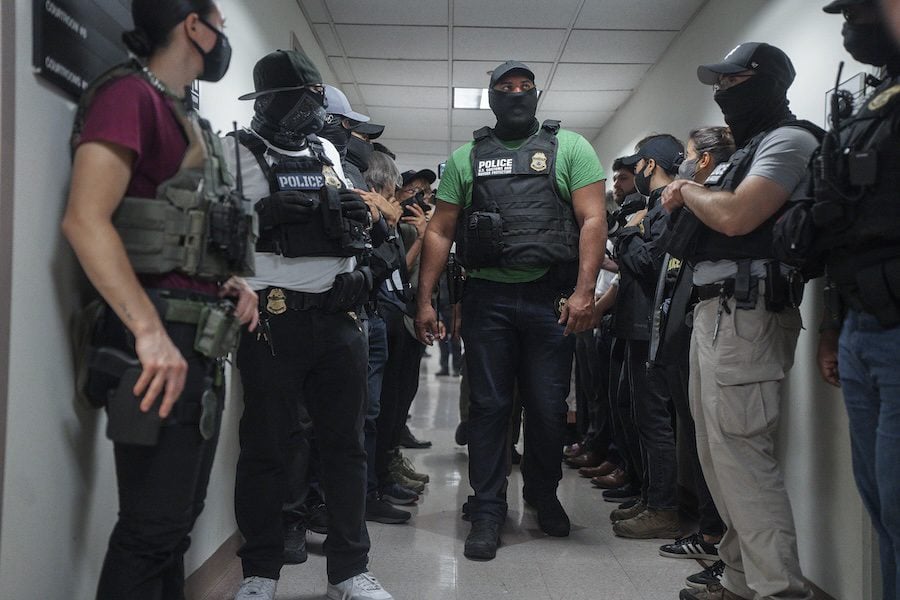
Masked federal agents wait outside an immigration courtroom on July 8, 2025, in New York. (AP Photo/Olga Fedorova)
Through the same historical methods that slave catchers abducted Black Americans off the streets, ICE under the authority of Trump’s executive order has spent the last several months detaining people from their homes, schools, hospitals, churches, courthouses, and workplaces; often without warrants signed by a judge or even reasonable cause. Many of these detainees were formally protected under Biden-era executive orders.
- More stories: How Stetson Kennedy Infiltrated the KKK & Changed the Jim Crow South
- More stories: Ruben Salazar Gave Voice to Chicanos Until He Was Killed by Police
- More stories: Reckless Eyeballing: How Matt Ingram’s Story Reveals Fear of Black Sexuality
The Role of Intimidation and Racism in ICE Raids
And like the slave patrols, ICE’s primary tactic under the new administration has been intimidation. Nonpartisan public policy and research organization The Cato Institute reports “a ninefold increase in immigrants being arrested by ICE and locked up by ICE for no other reason than their immigration status,” with 93% of detainees having no violent criminal history, and 65% having no criminal history at all. What’s more, “[ICE] is slapping thousands of ‘illegal entry’ charges on long-time residents to brand them as criminals and force California and other states to help deport them,” the Institute states.

On August 16, 2025, masked ICE agents violently arrested an immigrant advocate named Tatiana Martinez, who is known to livestream local ICE raids on TikTok. She was left unresponsive on the ground, eventually taken to a hospital then detention center. (Source)
And the ICE raids are not simply a matter of law and order, though the Trump administration has framed them as such. An obviously racist agenda, proven by years of Trump’s own rhetoric around migrants and the leadership of Trump’s appointed officials, drives the system.
An article published by the White House in late July praised Trump’s and ICE’s efforts, stating without evidence, “Across the country, arrests of criminal illegal immigrants have soared as President Donald J. Trump makes good on his promise to rid our communities of these threats to public safety — making sure illegal immigrant killers, rapists, gangbangers, and other violent criminals find no safe harbor.” The article also cited drastic increases in ICE arrests across 19 states, from the West Coast to the Midwest to the East Coast.

The White House releases a statement online that declares “illegal immigrant killers, rapists, gangbangers, and other violent criminals find no safe harbor” in the U.S. About half of the alleged sources provided by the federal government in this article are nothing more than unverified posts made by the White House itself on Twitter/X. (Source)
But in reality, it’s not about “rapists” and “gangbangers.” White House Deputy Chief of Staff Stephen Miller “wants everybody arrested,” an anonymous ICE official told the Washington Examiner in May. Trump officials have continually increased the detainment quotas for ICE since January, The Washington Post and Axios report, with former orders of a few hundred daily arrests becoming expectations of several thousand. These quotas harken back to the history of slave catcher bounties and encourage ICE to look not for specific convicts, but for mass numbers of people who might be undocumented. “‘Why aren’t you at Home Depot? Why aren’t you at 7-Eleven?’” Miller reportedly demanded of ICE leadership.
And it’s not just Latin American migrants that the administration is targeting with modern slave patrols: Middle Eastern immigrants are also suffering at the hands of immigration enforcement. The Department of Homeland Security “has ended protections for some Christians facing persecution in their homelands, such as Afghans,” according to Christianity Today. Other Middle Eastern asylum-seekers fleeing religious persecution have been detained by ICE without cause, with the only explanation provided being that the Biden-era policy which granted them legal residency “doesn’t matter” and “is no longer valid.” Asylum-seeking Iranian Christians have even been deported to Central and South American countries like Panama.
- More stories: Cesar Antonio Rodriguez: Killed By Long Beach Police Over $1.75 Fare
- More stories: Melyda Corado: Trader Joe’s Employee Killed By LAPD in 2018
- More stories: When Columbia Expelled Robert Burke for Anti-Nazi Protests in 1936
American Abolitionist Methods for Resisting Slave Catchers
After the passage of the Fugitive Slave Act of 1793, abolitionists and Northerners alike recognized that the statue had practically legalized kidnapping, and they rejected the idea that slave catchers could travel through free states to prey on free and freedom-seeking African Americans. In response, they developed methods of both public and private resistance against slave patrols, which continued diligently even after the Fugitive Slave Act of 1850 sought to deter and punish dissenters more severely.
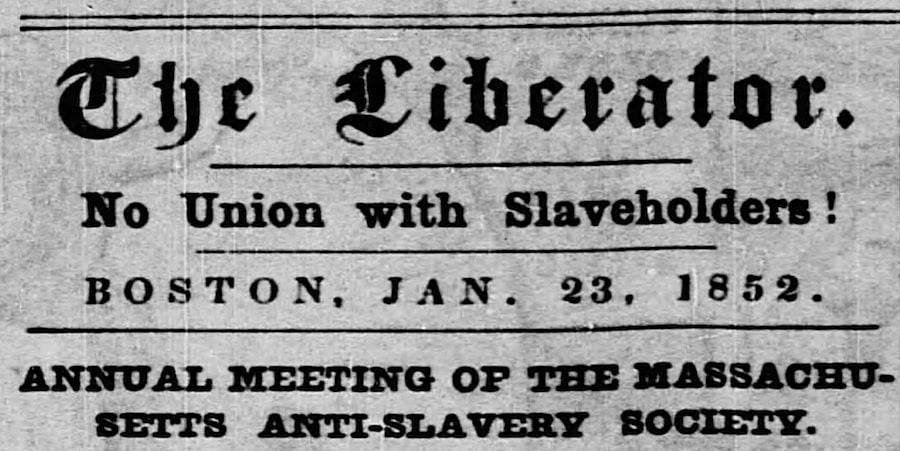
The slogan, “No union with slaveholders” was added to The Liberator’s masthead by William Lloyd Garrison as an abolitionist rallying cry for those opposed to slavery in America. (Source)
For example, abolitionists in Northern states worked to pass “personal liberty laws,” which counteracted, at least at the state level, parts of the first Fugitive Slave Act. These liberty laws gave accused fugitives the right to a jury trial and placed large fines on bounty hunters in an effort to protect both free Black citizens and freedom seekers. However, after the Fugitive Slave Act of 1850 created new statues which rendered these liberty laws ineffective, history shows that abolitionists turned to more discrete methods of resistance.
The Underground Railroad, the secret network of people, places, and travel routes which made up the anti-slavery resistance movement in the 19th century, worked in numerous ways to move freedom seekers out of the South and into Northern states and Canada.

Originally appearing in the now-defunct New York Herald in January 1860, this pro-slavery piece calls those engaging in the Underground Railroad “fanatical abolition agitators” who are “endangering the highest interests of the country.” (Source)
Abolitionists created systems of safe houses in which formerly enslaved people could find refuge on their journeys northward, while others raised money, provided food, and collected clothes and other items so they could eat, travel, and disguise themselves from potential slave catchers. “Vigilance committees” in Northern states also sought to aid freedom seekers via job searches and letters of recommendation for employment in hopes that the fleeing individuals could begin new lives away from enslavement.
- More stories: Police Killings of Unarmed Latinos in Los Angeles, 2016 – 2021
- More stories: How Isaac Wright Jr Overturned Life Sentence & Became a Lawyer
- More stories: El Negro Matapacos: The Riot Dogs Who Protect Protesters
How Today’s Anti-ICE Efforts Can Learn from the Historical Abolitionists
Modern community protection efforts against ICE raids can draw a number of lessons from the abolitionist methods against slave patrols. For instance, combating legal injustices at the state and local levels can create meaningful improvements for vulnerable individuals. Similarly to the history of personal liberty laws that followed the passage of the first Fugitive Slave Act, many American states and cities have passed “sanctuary policies,” or legal statues protecting the rights and well-being of immigrants based on the principle that state and local governments cannot be required by the federal government to participate in immigration enforcement.
While sanctuary policy does not prevent federal immigration officials from enacting their responsibilities, it can protect state and local officials from being forced to assist them. Today, hundreds of cities and roughly a dozen states across America have enacted sanctuary policy and other efforts to abolish ICE from their communities.
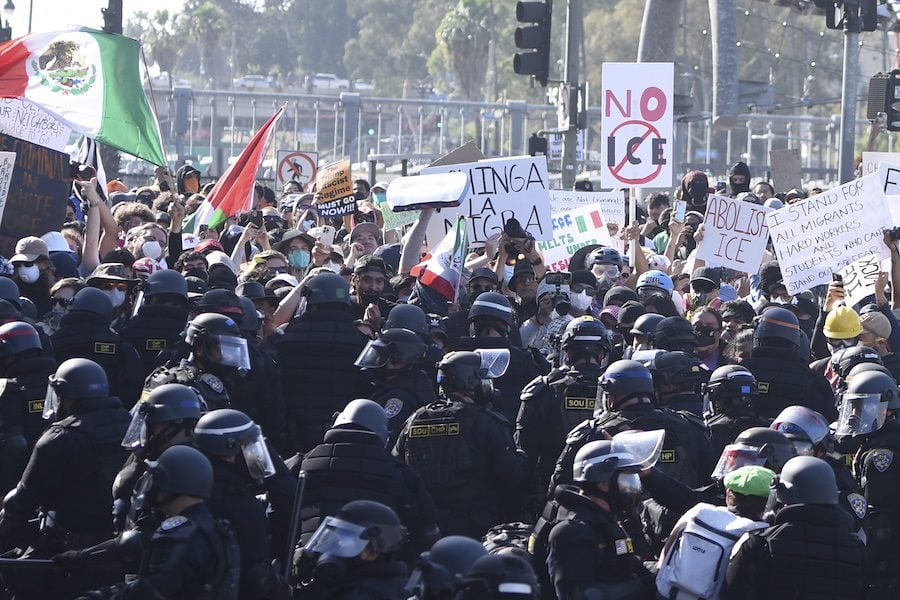
Protesters confront police following recent raids by ICE and Department of Homeland Security (DHS) agents on June 8, 2025 in Los Angeles. This marked the third day of unrest as thousands of protesters against recent immigration raids took to the streets of downtown Los Angeles to voice their opposition. (Photo by Zhang Shuo/China News Service/VCG via AP)
Protecting the individual rights of those targeted by ICE is also crucial. Regardless of immigration status, anyone on American soil is guaranteed certain Constitutional rights, and dozens of national, state, and local organizations have developed know-your-rights campaigns to help undocumented residents and allies understand those rights in the case of an encounter with immigration enforcement.
These organizations, like the National Immigrant Justice Center and American Immigration Lawyers Association, advocate using ICE’s online detainee locator, employing the right to remain silent, refusing search without probable cause or warrant, asking for home-search warrants signed by judges, and maintaining the right to a lawyer bond hearing before an immigration judge, among others.
Further, mutual aid networks and other grassroots local efforts dedicated to supporting at-risk community members provide services like grocery drop-off, educational opportunities, bond assistance, legal representation, and emergency funds for individuals struggling to pay their bills due to detained family members or loss of employment. Networks have sprung up all over the country, including in Los Angeles.
Community alert systems can likewise protect vulnerable individuals. Programs like ICE in my Area and ICEBlock allow users to report ICE sightings in their neighborhoods so that others can protect themselves from physical encounters with immigration agents.
The abolitionist efforts against slave patrol systems in the South prove that both political advocacy and grassroots community building are critical to protecting those against the whims of an unchecked federal government driven by prejudice and cruelty. Some 200 years later, gravely similar efforts to rein in federal overreach and abolish ICE are appearing again as a new generation faces all-too-familiar threats to life, liberty, and the pursuit of happiness in Trump’s America.
- More stories: The Lives of Ferguson & Black Lives Matter Activists Cut Short
- More stories: Amelio Robles Ávila: Transgender Fighter in Mexican Revolution
- More stories: How a Retractable Syringe Exposed Group Purchasing Organizations
- More stories: Zazu Nova’s Legacy at The Stonewall Riots






0 Comments